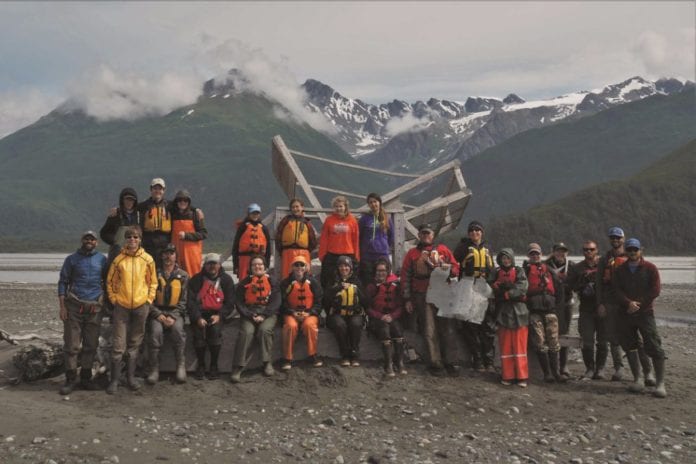
An epic journey ended on the banks of the Copper River last week. Thirteen high school students and 10 adults completed a 10-day trek from the northern reaches of the Copper River watershed to the mouth of the river, near Cordova.
The Copper River Watershed Project orchestrates this trip through the Copper River Stewardship Program. This year, seven Cordova High School students joined six students from various upriver communities, including Kenny Lake, Glennallen, Slana and Gakona.
From traveling through the northern boreal forests to lush temperate rainforests, students saw the stark contrast between the upriver and downriver ecosystems.
Thomas Abraham, 9th-grader from Slana, was thrilled to see bears, Dolly Varden, and huge trees for the first time.

Photo courtesy Meadow Scott
Elias Hanson, Cordova 9th-grader, said he never realized how challenging fishing methods were in the turbid upriver waters. Kristen Carpenter, executive director of the Copper River Watershed Project, said the trip gives students a chance to explore “their bigger backyard, because we all depend on the entire resource.”
Because Cordova is not connected by a man-made road system, the links among watershed communities are sometimes overlooked.
“When I was little, I used to think Miles Lake was the end,” Hanson said, sharing how he previously viewed the watershed.
This program encourages students to think about the watershed as a whole.
“We’re kind of on a balance,” Abraham said. “If something is off on one side, it can impact both sides of the scale.”
These realizations are crucial for sustainable resource management, which is ultimately the aim of the program, said program director, Kate Morse.
“These are the future stewards of the watershed,” Morse said. “The more they understand the importance of an intact, healthy ecosystem and the diversity of uses and lifestyles supported by salmon, the better decisions they might be inclined to make.”
Before setting off on the 91-mile rafting trip from Chitina to Cordova, students toured the Gulkana Hatchery, were introduced to the Alyeska Pipeline, and learned about fish wheels and other subsistence fishing techniques.
After setting off on their six-day rafting adventure, Morse describes how the students were amazed at the terrain changes — shifting away from places like Kenny Lake, which receives 9 to 10 inches of rain per year compared to Cordova, where similar rainfall can occur in a single day in September.
Students conducted three plant surveys along their route, first in the boreal forest, then on the banks of the Copper River and finally in the temperate rainforest at the mouth of the river.
They also got their feet wet in a citizen science project called ‘Salmon Blitz,’ in which participants document salmon habitat along the Copper River watershed, with the goal of informing future resource management decisions. Upon reaching Cordova, Meadow Scott, PWSSC education specialist, led students on a rainforest hike and helped them conduct a plant survey. See time-lapse video of the process at PWSSC’s Facebook page.
Additionally, the US Forest Service introduced students to Dusky Canada Goose nesting grounds on the Delta and the Alaska Department of Fish and Game showed students how and why they dissect fish ear bones, or otoliths, to learn more about their life histories.
“It takes a watershed to raise good watershed stewards,” Morse said. “There is a myriad of partners that make this program happen.”
Morse of the CRWP and Robin Mayo of the Wrangell Institute for Science and Environment were key educators on this trip, as well as Lauren Bien of the PWSSC and Glen Hart of Wrangell St. Elias National Park and Preserve. Additional Stewardship partners include the Bureau of Land Management and the US Forest Service. Morse also sends a big thank you to parents for facilitating their child’s participation and encourages the Cordova community to continue setting a good example for our youth by acting as good stewards of the Copper River watershed.














